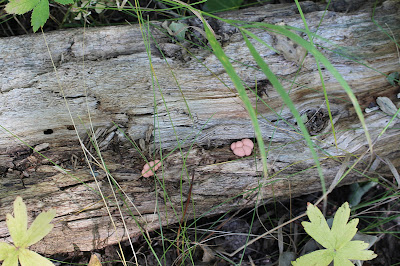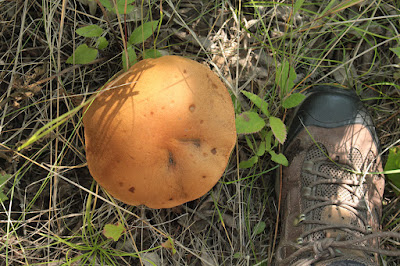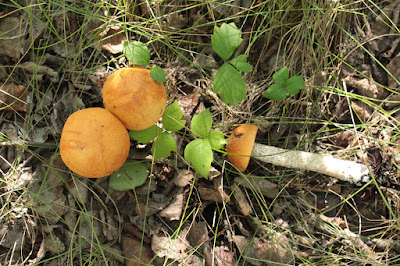Here are some interesting and photogenic mushrooms found in the
Assiniboine Forest. This page covers all fungi so far located in forest, whether a mushroom, a
bracket, a mold, or a fungal infection.
A mushroom (or toadstool) is the fleshy, spore-bearing fruiting body of a
fungus, typically produced above ground, on soil, or on its food source.
From a scientific perspective, toadstools are the same thing as mushrooms,
although people generally use the term toadstool to refer to toxic or
inedible mushrooms.
Brackets are the hard shell-like fruiting bodies of a fungus which is
infecting the tree or dead log. Softer varieties growing on trees or
logs are generally called mushrooms.
Although some molds are fungi, non-fungal molds are also shown here.
Species listed here under the heading of Fungal Infections are those which are
not brackets, mushrooms, or molds, are generally unattractive, and threaten to
deform or kill the host species.
Since the Habitat Site Report does not include any fungi, all species
headings are shown in
Bold Italic.
Brackets
Mushrooms
Molds
Fungal Infections
More
Click on Images to Enlarge
Brackets
Aspen Bracket
Phellinus tremulae
Native Perennial, also known as False Tinder Conk
Aspen Bracket is a hard, woody perennial mushroom that grows
from branch scars, that is, from the wound left when a branch
has broken off. For more photos of Aspen Bracket, see the
Aspen Bark page.
Jelly Ear
Auricularia auricula-judae
Native, also known as Judas's Ear, Jew's Ear
In this photo, there is one larger mushroom, and two
smaller ones to the right and slightly below.
Close-up. Be careful what you say in the
Assiniboine Forest. The forest has
ears.
It really looks as if somebody left their ears on
this log, in order to enjoy some peace and quiet in
the woods. To complete the illusion, the
mushroom has a firm but spongy texture very much like
that of ears.
Another Close-Up.
Artist's Bracket
Ganoderma applanatum
Native, also known as Artist's Conk, Artist's Fungus, Bear Bread
Fragrant Bracket
Trametes suaveolens
Native.
Mushrooms
Common Stinkhorn
Phallus impudicus
Native.
Fly Agaric
Amanita muscaria var. formosa
Native, also known as Yellow-Orange Fly Agaric, Fly Amanita
This photogenic mushroom, Fly Agaric, is
distinctive because of its cream-coloured
warts. Although often red in colour, the
variety Amanita muscaria var. formosa is orange, as in these examples. This
mushroom is hallucinogenic and toxic.
Molds
Pink Slime Mold
Lycogola epidendrum OR Fuligo septica
Native, also known as Wolf's Milk, Groening's Slime
While true molds are fungi, slime molds are not. Slime
molds are organisms that can live freely as single cells,
but can aggregate together to form multicellular
reproductive structures. There are over 900 species of
slime mold in the world.
I'm surprised I spotted this one. These guys are
tiny.
Fungal Infections
Black Canker
Ceratocystis fimbriata OR Ceratostomella fimbriata
Native, also known as Target Canker
See the exploration of Aspen bark on the Tree
page
Black Knot
Apiosporina morbosa OR Dibotryon morbosum
Native.
More
A Potpourri of Mushrooms
These are some mushrooms that I have yet to
identify, in part because I haven't examined their
gills and stalks closely. The differences between mushrooms similar in
appearance are often very subtle.
Specimen 1:
Specimen 2:
A distinctive mushroom with a cap toned in various
shades of pink.
I hate to disturb a mushroom in the forest, but
just a few times I've uprooted one in order to take
a look at the stem or the gills.
The gills of the above mushroom.
Specimen 3:
Specimen 4:
Specimen 6:
Fungal Curiosities
Curiosity 1:
When you look closely, this bracket is not smooth
but has a fuzzy, spiky exterior.
Curiosity 2:
This bracket does not have the characteristic
growth rings visible on the top of Aspen Bracket
fungi, and is possibly something else.
Curiosity 3:
An unidentified white bracket





































